Kenwood KDC-205CR, KDC-205, KDC-105 User Manual

KDC-205 KDC-205CR KDC-105
CD-RECEIVER
INSTRUCTION MANUAL
AMPLI-TUNER-LECTEUR DE CD
MODE D’EMPLOI
REPRODUCTOR DE DISCOS COMPACTOS RECEPTOR DE FM/AM
MANUAL DE INSTRUCCIONES
RECEPTOR DE CD
MANUAL DE INSTRUÇÕES
Take the time to read through this instruction manual. Familiarity with installation and operation procedures will help you obtain the best performance from your new CD-receiver.
For your records
Record the serial number, found on the back of the unit, in the spaces designated on the warranty card, and in the space provided below. Refer to the model and serial numbers whenever you call upon your KENWOOD dealer for information or service on the product.
Model KDC-205, KDC-205CR, KDC-105 Serial number
© B64-2670-00 / 00 (KN)
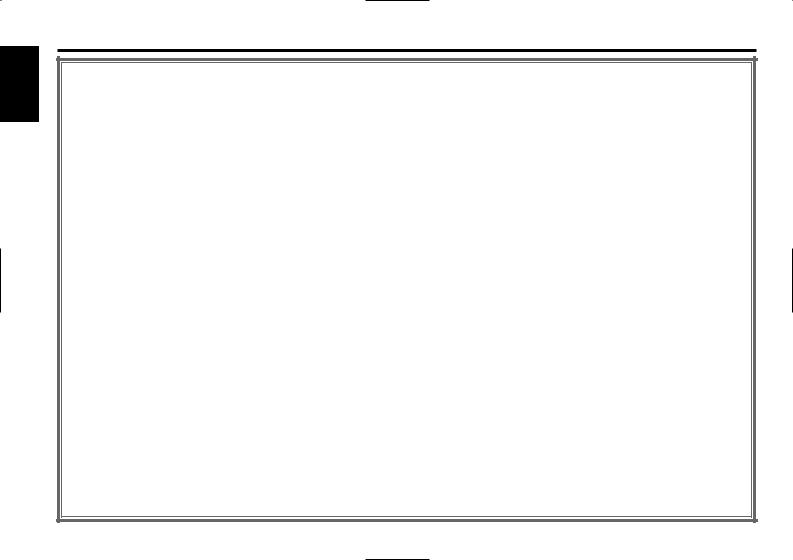
English
Contents
Safety precautions |
......................3 |
About CDs................................... |
5 |
General features ......................... |
6 |
Power
Selecting the Source
Volume
Attenuator
Loudness
System Q
Audio Control
Speaker Setting
Clock Display
Adjusting Clock
DSI (Disabled System Indicator)
Theft Deterrent Faceplate
Tuner features |
.............................9 |
Tuning Mode
Tuning
Station Preset Memory
Auto Memory Entry
Preset Tuning
CRSC (Clean Reception System Circuit)
CD player features.................... |
11 |
Playing CD |
|
Fast Forwarding and Reversing |
|
Track Search |
|
Track Repeat |
|
Track Scan |
|
Random Play |
|
Accessories............................... |
13 |
Installation Procedure .............. |
13 |
Connecting Wires |
|
to Terminals ........................... |
14 |
Installation ................................ |
15 |
Troubleshooting Guide ............. |
17 |
Specifications ........................... |
19 |
Warning ..................................... |
20 |
— 2 —

Safety precautions
2WARNING |
2CAUTION |
To prevent injury or fire, take the following precautions:
•Insert the unit all the way in until it is fully locked in place. Otherwise it may fall out of place when jolted.
•When extending the ignition, battery, or ground wires, make sure to use automotivegrade wires or other wires with a 0.75mm2 (AWG18) or more to prevent wire deterioration and damage to the wire coating.
•To prevent a short circuit, never put or leave any metallic objects (such as coins or metal tools) inside the unit.
•If the unit starts to emit smoke or strange smells, turn off the power immediately and consult your Kenwood dealer.
•Make sure not to get your fingers caught between the faceplate and the unit.
•Be careful not to drop the unit or subject it to strong shock.
The unit may break or crack because it contains glass parts.
•Do not touch the liquid crystal fluid if the LCD is damaged or broken due to shock. The liquid crystal fluid may be dangerous to your health or even fatal.
If the liquid crystal fluid from the LCD contacts your body or clothing, wash it off with soap immediately.
To prevent damage to the machine, take the following precautions:
•Make sure to ground the unit to a negative 12V DC power supply.
•Do not open the top or bottom covers of the unit.
•Do not install the unit in a spot exposed to direct sunlight or excessive heat or humidity. Also avoid places with too much dust or the possibility of water splashing.
•Do not set the removed faceplate or the faceplate case in areas exposed to direct sunlight, excessive heat or humidity. Also avoid places with too much dust or the possibility of water splashing.
•To prevent deterioration, do not touch the terminals of the unit or faceplate with your fingers.
•Do not subject the faceplate to excessive shock, as it is a piece of precision equipment.
•When replacing a fuse, only use a new one with the prescribed rating. Using a fuse with the wrong rating may cause your unit to malfunction.
•To prevent a short circuit when replacing a fuse, first disconnect the wiring harness.
•Do not place any object between the faceplate and the unit.
•Do not use your own screws. Use only the screws provided. If you use the wrong screws, you could damage the unit.
Do Not Load 3-in. CDs in the CD slot
If you try to load a 3 in. CD with its adapter into the unit, the adapter might separate from the CD and damage the unit.
— 3 —

English
Safety precautions
NOTE
•If you experience problems during installation, consult your Kenwood dealer.
•If the unit does not seem to be working right, try pressing the reset button first. If that does not solve the problem, consult your Kenwood dealer.
|
|
|
|
|
CRSC |
AUD |
OFF |
SCAN |
RDM |
REP |
CLK ADJ |
AUTO 
Reset button
•Characters in the LCD may become difficult to read in temperatures below 41 ˚F (5 ˚C).
•The illustrations of the display and the panel appearing in this manual are examples used to explain more clearly how the controls are used. Therefore, what appears on the display in the illustrations may differ from what appears on the display on the actual equipment, and some of the illustrations on the display may represent something impossible in actual operation.
Cleaning the Faceplate Terminals
If the terminals on the unit or faceplate get dirty, wipe them with a dry, soft cloth.
Cleaning the Unit
If the faceplate of this unit is stained, wipe it with a dry soft cloth such as a silicon cloth.
If the faceplate is stained badly, wipe the stain off with a cloth moistened with neutral cleaner, then wipe neutral detergent off.
Applying spray cleaner directly to the unit may affect its mechanical parts. Wiping the faceplate with a hard cloth or using a volatile liquid such as thinner or alcohol may scratch the surface or erases characters.
Cleaning the CD Slot
As dust tends to accumulate in the CD slot, clean it every once in a while. Your CDs can get scratched if you put them in a dusty CD slot.
Lens Fogging
Right after you turn on the car heater in cold weather, dew or condensation may form on the lens in the CD player of the unit. Called lens fogging, CDs may be impossible to play. In such a situation, remove the disc and wait for the condensation to evaporate. If the unit still does not operate normally after a while, consult your Kenwood dealer.
— 4 —

About CDs
Handling CDs
• Don’t touch the recording surface of the CD.
•CD-R and CD-RW are easier to damage than a normal music CD. Use a CD-R or a CD-RW after reading the caution items on the package etc.
•Don’t stick tape etc. on the CD.
Also, don’t use a CD with tape stuck on it.
When using a new CD
If the CD center hole or outside rim has burrs, use it after removing them with a ball pen etc.
Burrs
Burrs
CD cleaning
Clean from the center of the disc and move outward.
Removing CDs
When removing CDs from this unit pull them out horizontally.
CDs that can’t be used
• CDs that aren’t round can’t be used.
•CDs with coloring on the recording surface or that are dirty can’t be used.
•This unit can only play the CDs with


 .
.
It may not correctly play discs which do not have the mark.
•A CD-R or CD-RW that hasn’t been finalized can’t be played. (For the finalization process refer to your CD-R/CD-RW writing software, and your CD-R/CD-RW recorder instruction manual.)
CD storage
•Don’t place them in direct sunlight (On the seat or dashboard etc.) and where the temperature is high.
•Store CDs in their cases.
CD accessories
Don’t use disc type accessories.
— 5 —

English
General features
Release button |
|
Power |
|
Turning ON the Power |
|
(KDC-205/KDC-205CR only) |
4 AM FM ¢ |
|
u d |
Press the [SRC] button. |
Turning OFF the Power
Press the [SRC] button for at least 1 second.
 CRSC
CRSC
LOUD |
|
|
|
|
|
|
Selecting the Source |
|
AME |
AUTO |
OFF |
|
|
|
|
|
|
|
AUD |
SCAN |
RDM |
REP |
CLK ADJ |
|
|
|
|
|
|
|
|
||||
|
|
|
|
|
|
|
Press the [SRC] button. |
|
ATT/ |
Q/ |
SRC |
1 |
3 |
|
CLK/ |
Source required |
Display |
|
Tuner |
"TUnE" |
||||||
LOUD |
AUD |
|
|
|
|
ADJ |
||
|
|
|
|
|
|
|
CD |
"CD" |
|
|
|
|
|
|
|
Standby (Illumination only mode) |
"STBY" |
LOUD indicator
SYSTEM Q indicator |
Clock display |
ATT indicator |
Volume
Increasing Volume
Press the [u] button.
Decreasing Volume
Press the [d] button.
Attenuator
Turning the volume down quickly.
Press the [ATT] button.
Each time the button is pressed the Attenuator turns ON or OFF. When it’s ON, the "ATT" indicator blinks.
— 6 —
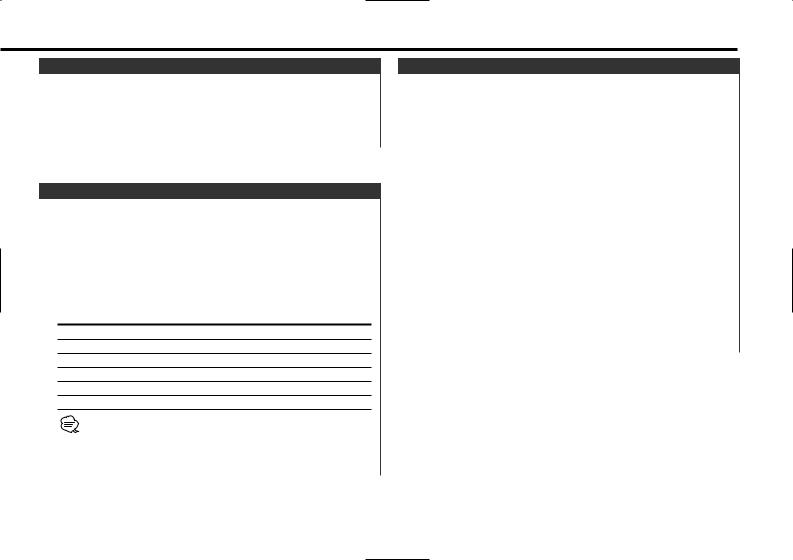
Loudness
Compensating for low and high tones during low volume.
Press the [LOUD] button for at least 1 second.
Each time the button is pressed for at least 1 second the Loudness turns ON or OFF.
When it’s ON, "LOUD" indicator is ON.
System Q
You can recall the best sound setting preset for different types of the music.
1Select the source to set
Press the [SRC] button.
2Select the Sound type
Press the [Q] button.
Each time the button is pressed the sound setting switches.
Sound setting |
Display |
Flat |
"FLAT" |
Rock |
"ROCK" |
Top 40 |
"TP40" |
Pops |
"POPS" |
Jazz |
"JAZZ" |
Easy |
"EASY" |
•Each setting value is changed with the <Speaker setting> (page 8).
First, select the speaker type with the Speaker setting.
•When the System Q setting is changed, the Bass, Middle, and Treble set in audio control replace the System Q values.
Audio Control
1Select the source for adjustment
Press the [SRC] button.
2Enter Audio Control mode
Press the [AUD] button for at least 1 second.
3Select the Audio item for adjustment
Press the [FM] or [AM] button.
Each time the button is pressed the items that can be adjusted switch as shown below.
4Adjust the Audio item
Press the [4] or [¢] button.
Adjustment Item |
Display |
Range |
Bass level |
"BAS" |
–8 — +8 |
Middle level |
"MID" |
–8 — +8 |
Treble level |
"TRE" |
–8 — +8 |
Balance |
"BL" |
Left 15 — Right 15 |
Fader |
"FD" |
Rear 15 — Front 15 |
5Exit Audio Control mode
Press the [AUD] button.
— 7 —

English
General features
Speaker Setting
Fine-tuning so that the System Q value is optimal when setting the speaker type.
1Enter Standby
Press the [SRC] button.
Select the "STBY" display.
2Enter Speaker Setting mode
Press the [Q] button.
3Select the Speaker type
Press the [4] or [¢] button.
Each time the button is pressed the setting switches as shown below.
Speaker type |
Display |
|
OFF |
|
"SP-F" |
For the OEM speaker |
"SP-O" |
|
For 6 |
& 6x9 in. speaker |
"SP-6" |
For 5 |
& 4 in. speaker |
"SP-5" |
4Exit Speaker Setting mode
Press the [Q] button.
Clock Display
Press the [CLK] button.
Each time the button is pressed the clock display turns ON or OFF.
Adjusting Clock
1Select the clock display
Press the [CLK] button.
2Enter clock adjustment mode
Press the [ADJ] button for at least 2 seconds.
The clock display blinks.
3Adjust the hours
Press the [FM] or [AM] button.
Adjust the minutes
Press the [4] or [¢] button.
4Exit clock adjustment mode
Press the [CLK] button.
Function of the KDC-205/KDC-205CR
DSI (Disabled System Indicator)
A red indicator will blink on the unit after the faceplate is removed, warning potential thieves.
1Turn the power OFF
Press the [SRC] button for at least 1 second.
2Set the DSI
While pressing the [1] and [3] button, press the [SRC] button.
Each time the step 1 and 2 operation is done the DSI turns ON or OFF.
— 8 —

Function of the KDC-205/KDC-205CR
Theft Deterrent Faceplate
The faceplate of the unit can be detached and taken with you, helping to deter theft.
Removing the Faceplate
Press the Release button.
The faceplate is unlocked, allowing you to detach it.
• The faceplate is a precision piece of equipment and can be damaged by shocks or jolts. For that reason, keep the faceplate in its special storage case while detached.
•Do not expose the faceplate or its storage case to direct sunlight or excessive heat or humidity. Also avoid places with too much dust or the possibility of water splashing.
Reattaching the Faceplate
1Align the projections on the unit with the grooves on the faceplate.
2Push the faceplate in until it clicks.
The faceplate is locked in place, allowing you to use the unit.
Tuner features
|
|
4 AM |
FM/ |
|
|
CRSC ¢ |
|
|
|
|
CRSC |
LOUD |
|
|
|
AUD |
OFF |
SCAN RDM REP |
CLK ADJ |
AME AUTO |
|
|
|
AUTO/ |
SRC |
1 - 6 |
AME |
|
|
Band display |
Preset station number |
Frequency display |
ST indicator |
AUTO indicator |
CRSC indicator |
— 9 —

English
Tuner features
Tuning Mode
Choose the tuning mode.
Press the [AUTO] button.
Each time the button is pressed the Tuning mode switches as shown below.
Tuning mode |
Display |
Operation |
Auto seek |
"AUTO 1" |
Automatic search for a station. |
|
indicator |
|
Preset station |
"AUTO 2" |
Search in order of the stations |
seek |
indicator |
in the Preset memory. |
Manual |
— |
Normal manual tuning control. |
Tuning
Selecting the station.
1Select tuner source
Press the [SRC] button.
Select the "TUnE" display.
2Select the band
Press the [FM] or [AM] button.
Each time the [FM] button is pressed it switches between the FM1, FM2, and FM3 bands.
3Tune up or down band
Press the [4] or [¢] button.
 During reception of stereo stations the "ST" indicator is ON.
During reception of stereo stations the "ST" indicator is ON.
Station Preset Memory
Putting the station in the memory.
1Select the band
Press the [FM] or [AM] button.
2Select the frequency to put in the memory
Press the [4] or [¢] button.
3Put the frequency in the memory
Press the [1] — [6] button for at least 2 seconds.
The preset number display blinks 1 time.
On each band, 1 station can be put in the memory on each [1] — [6] button.
Auto Memory Entry
Putting stations with good reception in the memory automatically.
1Select the band for Auto Memory Entry
Press the [FM] or [AM] button.
2Open Auto Memory Entry
Press the [AME] button for at least 2 seconds.
When 6 stations that can be received are put in the memory Auto Memory Entry closes.
Preset Tuning
Calling up the stations in the memory.
1Select the band
Press the [FM] or [AM] button.
2Call up the station
Press the [1] — [6] button.
—10 —
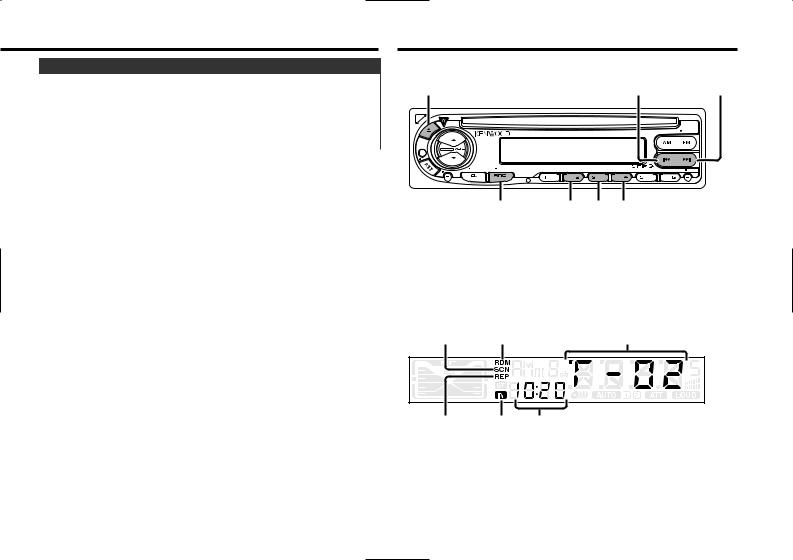
CRSC (Clean Reception System Circuit)
Temporarily have reception switched from stereo to mono to reduce multi-path noise when listening to the FM station.
Press the [CRSC] button for at least 1 second.
Each time the button is pressed CRSC turns ON or OFF. When it's ON, the "CRSC" indicator is ON.
CD player features
0 |
|
|
4 |
¢ |
|
|
|
|
CRSC |
LOUD |
|
|
|
|
AUD OFF |
SCAN |
RDM |
REP |
CLK ADJ |
AME AUTO |
|
|
|
|
SRC |
SCAN |
RDM |
REP |
|
SCN |
RDM |
Track number |
indicator |
indicator |
REP indicator IN indicator |
Track time |
— 11 —
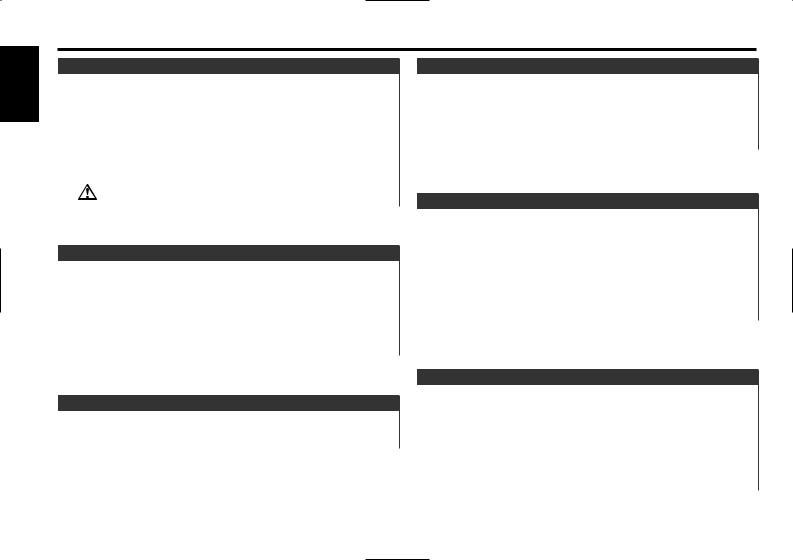
English
CD player features
Playing CD
When a CD is inserted
Press the [SRC] button.
Select the "CD" display.
 When a CD is inserted, the "IN" indicator is ON.
When a CD is inserted, the "IN" indicator is ON.
Eject the CD
Press the [0] button.
3 in. (8cm) CD cannot be played. Using an adapter and inserting them into this unit can cause damage.
Fast Forwarding and Reversing
Fast Forwarding
Hold down on the [¢] button.
Release your finger to play the disc at that point.
Reversing
Hold down on the [4] button.
Release your finger to play the disc at that point.
Track Search
Selecting the song you want to hear.
Press the [4] or [¢] button.
Track Repeat
Replaying the song you're listening to.
Press the [REP] button.
Each time the button is pressed the Track Repeat turns ON or OFF.
When it's ON, the "REP" indicator is ON.
Track Scan
Playing the first part of each song on the disc you are listening to and searching for the song you want to listen to.
1Start Track Scan
Press the [SCAN] button.
"SCN" indicator is ON.
2Release it when the song you want to listen to is played
Press the [SCAN] button.
Random Play
Playing all the songs on the disc in random order.
Press the [RDM] button.
Each time the button is pressed Random Play turns ON or OFF. When it's ON, the "RDM" indicator is ON and the track number blinks.
 When the [¢] button is pressed, the next song select starts.
When the [¢] button is pressed, the next song select starts.
— 12 —
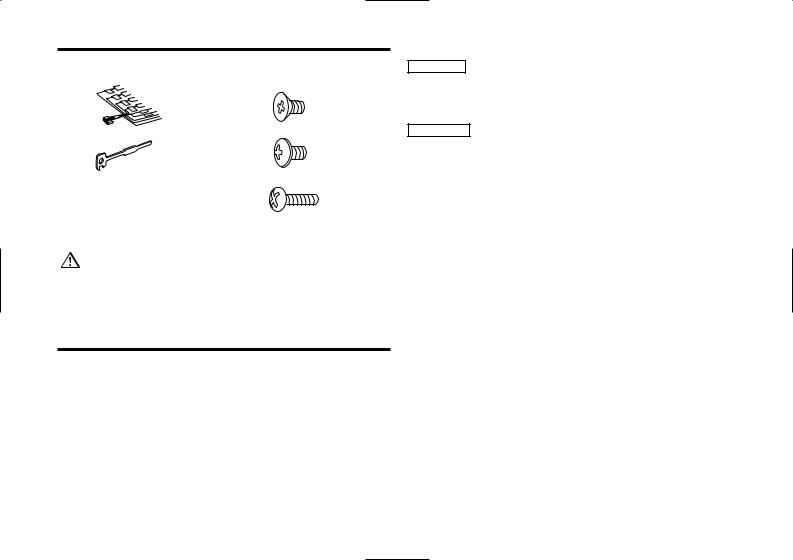
Accessories
External view |
External view |
......... Number of items |
......... Number of items |
1 |
1 |
3 |
.........4 |
|
|
|
|
2 ......... |
2 |
4 |
.........4 |
|
|
5 |
.........1 |
|
|
|
(KDC-205/KDC-205CR only) |
The use of any accessories except for those provided might result in damage to the unit. Make sure only to use the accessories shipped with the unit, as shown above.
Installation Procedure
1.To prevent a short circuit, remove the key from the ignition and disconnect the - battery.
2.Make the proper input and output wire connections for each unit.
3.Connect the speaker wires of the wiring harness.
4.Connect the wiring harness wires in the following order: ground, battery, ignition.
5.Connect the wiring harness connector to the unit.
6.Install the unit in your car.
7.Reconnect the - battery.
8.Press the reset button.
2WARNING
If you connect the ignition wire (red) and the battery wire (yellow) to the car chassis (ground), you may cause a short circuit, that in turn may start a fire. Always connect those wires to the power source running through the fuse box.
2CAUTION
•If your car's ignition does not have an ACC position, connect the ignition wires to a power source that can be turned on and off with the ignition key. If you connect the ignition wire to a power source with a constant voltage supply, as with battery wires, the battery may die.
•If the console has a lid, make sure to install the unit so that the faceplate will not hit the lid when closing and opening.
•If the fuse blows, first make sure the wires aren’t touching to cause a short circuit, then replace the old fuse with one with the same rating.
•Insulate unconnected wires with vinyl tape or other similar material. To prevent a short circuit, do not remove the caps on the ends of the unconnected wires or the terminals.
•Connect the speaker wires correctly to the terminals to which they correspond. The unit may be damaged or fail to work if you share the - wires or ground them to any metal part in the car.
•When only two speakers are being connected to the system, connect the connectors either to both the front output terminals or to both the rear output terminals (do not mix front and rear). For example, if you connect the + connector of the left speaker to a front output terminal, do not connect the - connector to a rear output terminal
•After the unit is installed, check whether the brake lamps, blinkers, wipers, etc. on the car are working properly.
•Mount the unit so that the mounting angle is 30° or less.
— 13 —

English
Connecting Wires to Terminals
If no connections are made, do not let the wire come out from the tab.4
Fuse (10A)
6 Connect either to the power control terminal when using the optional power amplifier, or to the antenna control terminal in the vehicle.
Not Used9
Do not let the wire come out from the tab. 4b
Not Used9
P.CONT
ANT.
CONT.
TEL MUTE
Power control/Motor antenna control wire (Blue/White)
16
Ignition key switch
10
Car fuse box (Main fuse)
11
+ |
– |
|
Do not let the wire come out from the tab. 4b
ACC 13
Ignition wire (Red) 20
Battery wire (Yellow) 21
Car fuse box 14
Ground wire (Black) · (To car chassis) 22
Rear left output (White) 23
Rear right output (Red) 28
REAR L
FM/AM antenna input 1
R 



Wiring harness (Accessory1)25
29
White/Black
|
To front left |
FRONT • L |
speaker 30 |
White
32 31
Gray/Black
To front right
FRONT • R  speaker 33
speaker 33
Gray
35 34
Green/Black
|
To rear left |
REAR • L |
speaker 36 |
|
Green |
38 |
37 |
Purple/Black |
|
|
To rear right |
REAR • R |
speaker 39 |
|
Purple |
|
40 |
Battery 12
— 14 —

Installation
■ Installation
Firewall or metal support
Screw (M4X8) (commercially available)
Self-tapping screw (commercially available)
Bend the tabs of the mounting sleeve with a screwdriver or similar utensil and
attach it in place.
Metal mounting strap (commercially available)
Make sure that the unit is installed securely in place. If the unit is unstable, it may malfunction (for example, the sound may skip).
■Installing in Japanese-Made Cars
1Refer to the section "Removing the hard rubber frame" (page 16) and then remove the hard rubber frame.
2Align the holes in the unit (two locations on each side) with the vehicle mounting bracket and secure the unit with the accessory screws.
T |
N |
|
|
|
|
|
|
|
|
|
|
|
|
|
|
8 mm |
8mm |
|
|
|
|
MAX. |
|
N |
|
T/N |
|
MAX. |
|
T |
3 |
|
|||
|
4 |
||||
|
|
|
|||
|
|
ø5mm |
|
|
|
|
|
|
|
ø5mm |
T: Toyota cars
N: Nissan cars Accessory3...for Nissan car Accessory4 ...for Toyota car
• During installation, do not use any screws except for those provided. The use of different screws might result in damage to the main unit.
•Damage may occur if a screwdriver or similar tool is used with excessive force during the installations.
■Screwing the Faceplate on the Unit (KDC-205/205CR only)
If you want to fasten the |
Accessory5 |
faceplate to the main unit so |
|
that it does not fall off, |
|
screw in the provided screw |
|
(ø4 X 16 mm) in the hole |
|
shown below. |
|
Never insert the taptite screw (ø4 × 16 mm) in any other screw hole than the one specified. If you screw it in another hole, it will contact and may cause damage to the mechanical parts inside the unit.
— 15 —

English
Installation
■Removing the hard rubber frame
1Engage the catch pins on the removal tool and remove the two locks on the lower level.
Lower the frame and pull it forward as shown in the figure.
Catch
Lock
 Accessory2
Accessory2
Removal tool
2When the lower level is removed, remove the upper two locations.
 The frame can be removed from the top side in the same manner.
The frame can be removed from the top side in the same manner.
■Removing the Unit
1Refer to the section “Removing the hard rubber frame” and then remove the hard rubber frame.
2Remove the screw (M4 × 8) on the back panel.
3Insert the two removal tools deeply into the slots on each side, as shown.
Screw (M4X8) |
Accessory2 |
|
Removal tool |
||
(commercially |
||
|
available)
4Lower the removal tool toward the bottom, and pull
out the unit halfway while pressing towards the inside.
Be careful to avoid injury from the catch pins on the removal tool.
5Pull the unit all the way out with your hands, being
careful not to drop it.
— 16 —

Troubleshooting Guide
What might seem to be a malfunction in your unit may just be the result of slight misoperation or miswiring. Before calling service, first check the following table for possible problems.
General
?The power does not turn ON.01
The fuse has blown.
After checking for short circuits in the wires, replace the fuse with one with the same rating.
No ACC position on vehicle ignition.02
Connect the same wire to the ignition as the battery wire.
?Nothing happens when the buttons are pressed.04
The computer chip in the unit is not functioning normally.
Press the reset button on the unit (page 4).
?There’s a source you can’t switch.06
There’s no CD inserted.
Set the media you want to listen to. If there’s no media in this unit, you can't swhich to each source.
?The memory is erased when the ignition is turned OFF.10
The battery wire has not been connected to the proper terminal.
Connect the wire correctly, referring to the section on <Connecting Wires to Terminals> (page 14).
The ignition and battery wire are incorrectly connected.11
Connect the wire correctly, referring to the section on <Connecting Wires to Terminals> (page 14).
?Even if Loudness is turned ON, high-pitched tone isn't compensated for. 17
Tuner source is selected.
High-pitched tone isn't compensated for when in Tuner source.
?No sound can be heard, or the volume is low.
The fader or balance settings are set all the way to one side.21
Center the fader and balance settings.
The input/output wires or wiring harness are connected incorrectly.22
Reconnect the input/output wires or the wiring harness correctly. See the section on <Connecting Wires to Terminals> (page 14).
?The sound quality is poor or distorted.25
One of the speaker wires is being pinched by a screw in the car.
Check the speaker wiring.
The speakers are not wired correctly.27
Reconnect the speaker wires so that each output terminal is connected to a different speaker.
?The Touch Sensor Tone doesn’t sound.34
The preout jack is being used.
The Touch Sensor Tone can’t be output from the preout jack.
Tuner source
?Radio reception is poor.39
The car antenna is not extended.
Pull the antenna out all the way.
The antenna control wire is not connected.40
Connect the wire correctly, referring to the section on <Connecting Wires to Terminals> (page 14).
— 17 —

English
Troubleshooting Guide
Disc source
?The specified disc does not play, but another one plays instead.52
The specified CD is quite dirty.
Clean the CD.
The CD is upside-down.53
Load the CD with the labeled side up.
The disc is severely scratched.55
Try another disc instead.
?The specified track will not play.58-a
Random play has been selected.
Turn off random play.
?Track repeat, track scan, and random play start by themselves.59-a
The setting is not canceled.
The settings for these functions remain on until the setting to off or the disc ejected, even if the power is turned off or the source changed.
?Cannot play CD-R or CD-RW.60
?Track Search can't be done.66-2
For the albums first or last song.
For each album, Track Search can't be done in the backward direction for the first song or in the forward direction for the last song.
The messages shown below display your systems condition.
E-04: |
The CD is quite dirty. The CD is upside-down. The CD |
|
is scratched a lot. |
|
Clean the CD and load it correctly. |
IN (Blink): |
The CD player section is not operating properly.E59 |
|
Reinsert the CD. If the CD cannot be ejected or the |
|
display continues to flash even when the CD has |
|
been properly reinserted, please switch off the |
|
power and consult your nearest service center. |
Finalization processing is not being conducted for CD-R/CD-RW.
Conduct finalization processing with CD recorder.
?A CD ejects as soon as it is loaded.62
The CD is upside-down.
Load the CD with the labeled side up.
The CD is quite dirty.63
Clean the CD, referring to the section on <CD cleaning> (page 5).
?Can’t remove disc.64
The cause is that more than 10 minutes has elapsed since the vehicle ACC switch was turned OFF.
The disc can only be removed within 10 minutes of the ACC switch being turned OFF. If more than 10 minutes has elapsed, turn the ACC switch ON again and press the Eject button.
?The disc won’t insert.65
There’s already another disc inserted.
Press the [0] button and remove the disc.
— 18 —

Specifications
Specifications subject to change without notice.
FM tuner section |
|
Audio section |
|
Frequency range (200 kHz space) |
............87.9 MHz – 107.9 MHz |
Maximum output power |
|
Usable sensitivity (S/N = 30dB) .................... |
9.3dBf (0.8 µV/75 Ω) |
KDC-205 .................................................................... |
50 W x 4 |
Quieting Sensitivity (S/N = 50dB) ............... |
15.2dBf (1.6 µV/75 Ω) |
KDC-205CR/105......................................................... |
45 W x 4 |
Frequency response (±3 dB) ................................. |
30 Hz – 15 kHz |
Full Bandwidth Power (at less than 1% THD) |
................22 W x 4 |
Signal to Noise ratio (MONO) .............................................. |
70 dB |
Tone action |
|
Selectivity (±400 kHz)....................................................... |
≥ 80 dB |
Bass : ............................................................... |
100 Hz ±10 dB |
Stereo separation (1 kHz) .................................................... |
40 dB |
Middle : .............................................................. |
1 kHz ±10 dB |
AM tuner section |
|
Treble : ............................................................. |
10 kHz ±10 dB |
|
Preout level / Load (during disc play).................... |
2000 mV/10 kΩ |
|
Frequency range (10 kHz space) ................... |
530 kHz – 1700 kHz |
Preout impedance ............................................................ |
≤ 600 Ω |
Usable sensitivity (S/N = 20dB) ............................. |
28 dBµ (25 µV) |
General |
|
CD player section |
|
|
|
|
Operating voltage (11 – 16V allowable) .............................. |
14.4 V |
|
Laser diode ....................................................................... |
GaAlAs |
Current consumption............................................................. |
10 A |
Digital filter (D/A)...................................... |
8 Times Over Sampling |
Installation Size (W x H x D) .......................... |
182 x 53 x 155 mm |
D/A Converter ....................................................................... |
1 Bit |
7-3/16 x 2-1/16 x 6-1/10 inch |
|
Spindle speed ............................................... |
500 – 200 rpm (CLV) |
Weight................................................................... |
3.1 lbs (1.4 kg) |
Wow & Flutter........................................ |
Below Measurable Limit |
|
|
Frequency response (±1 dB) ................................. |
10 Hz – 20 kHz |
|
|
Total harmonic distortion (1 kHz) ...................................... |
0.01 % |
|
|
Signal to Noise ratio (1 kHz) ................................................ |
93 dB |
|
|
Dynamic range .................................................................... |
93 dB |
|
|
Channel separation.............................................................. |
85 dB |
|
|
— 19 —
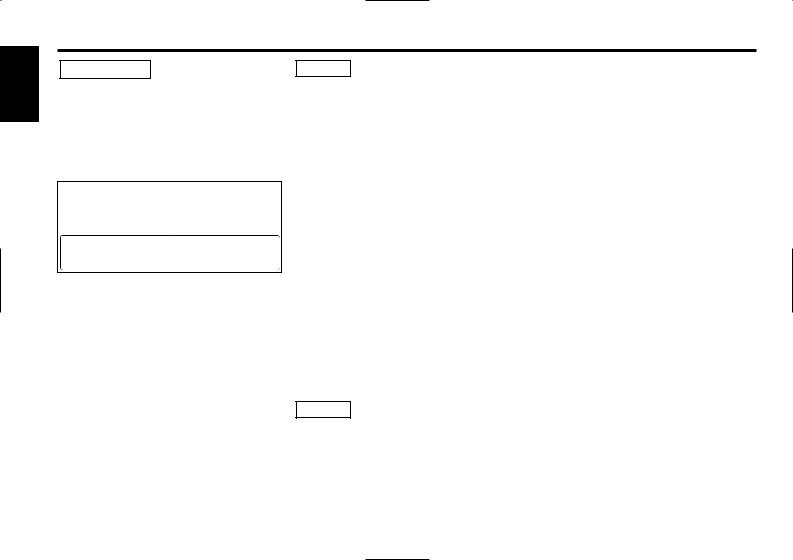
English
2Warning
2CAUTION
Use of controls or adjustments or performance of procedures other than those specified herein may result in hazardous radiation exposure.
In compliance with Federal Regulations, following are reproductions of labels on, or inside the product relating to laser product safety.
KENWOOD CORPORATION 2967-3, ISHIKAWA-CHO, HACHIOJI-SHI
TOKYO, JAPAN
KENWOOD CORP. CERTIFIES THIS EQUIPMENT CONFORMS TO DHHS REGULATIONS N0.21 CFR 1040. 10, CHAPTER 1, SUBCHAPTER J.
Location : Bottom Panel
FCC WARNING
This equipment may generate or use radio frequency energy. Changes or modifications to this equipment may cause harmful interference unless the modifications are expressly approved in the instruction manual. The user could lose the authority to operate this equipment if an unauthorized change or modification is made.
NOTE
This equipment has been tested and found to comply with the limits for a Class B digital device, pursuant to Part 15 of the FCC Rules. These limits are designed to provide reasonable protection against harmful interference in a residential installation. This equipment may cause harmful interference to radio communications, if it is not installed and used in accordance with the instructions. However, there is no guarantee that interference will not occur in a particular installation. If this equipment does cause harmful interference to radio or television reception, which can be determined by turning the equipment off and on, the user is encouraged to try to correct the interference by one or more of the following measures:
•Reorient or relocate the receiving antenna.
•Increase the separation between the equipment and receiver.
•Connect the equipment into an outlet on a circuit different from that to which the receiver is connected.
•Consult the dealer or an experienced radio/TV technician for help.
NOTE
This Class B digital apparatus complies with Canadian ICES-003.
— 20 —


Français
Table des matiéres
Précautions de sécurité............ |
23 |
Au sujet des CD ....................... |
25 |
Caractéristiques générales ....... |
26 |
Alimentation
Sélectionner la source
Volume
Atténuateur
Bruit
System Q
Commande du son
Réglage des enceintes
Affichage de l'horloge
Régler l'horloge
DSI (Disabled System Indicator)
Façade antivol
Fonctions du tuner |
...................29 |
Mode d'accord Accord
Mémoire de station pré-réglée Entrée en mémoire automatique Accord pré-réglé
CRSC (Circuit de réception nette)
Caractéristiques du |
|
lecteur CD .............................. |
31 |
Lire un CD
Avance rapide et retour
Recherche de plages
Répétition de plage
Balayage des plages
Lecture aléatoire
Accessoires ............................... |
33 |
Procédure d’installation ........... |
33 |
Connexion des câbles sur les |
|
prises...................................... |
34 |
Installation ................................ |
35 |
Guide de depannage ................. |
37 |
Spécifications ........................... |
39 |
— 22 —

Précautions de sécurité
2AVERTISSEMENT
Pour éviter toute blessure et/ou incendie, veuillez prendre les précautions suivantes:
•Insérez l’appareil à fond jusqu’à ce qu’il soit complètement calé. Sinon, il risquerait d’être projeté en cas de collisions ou de cahots.
•Si vous prolongez un câble d’alimentation, de batterie ou de masse, assurez vous d’utiliser un câble pour automobile ou un câble avec une section de 0,75mm2 (AWG18) afin d’éviter tous risques de détérioration ou d’endommagement du revêtement des câbles.
•Pour éviter les court-circuits, ne jamais mettre ou laisser d’objets métalliques (comme une pièce de monnaie ou un outil en métal) à l’intérieur de l’appareil.
•Si l’appareil commence à émettre de la fumée ou une odeur bizarre, mettez immédiatement l’appareil hors tension et consultez un revendeur Kenwood.
•Faites attention de ne pas vous prendre les doigts entre la façade et l’appareil.
•Faites attention de ne pas laisser tomber l’appareil ou lui faire subir de chocs importants. L’appareil risque de se casser ou de se fêler car il contient des parties en verre.
•Ne touchez pas le cristal liquide si l’affichage LCD était endommagé ou cassé à cause d’un choc. Le cristal liquide peut être dangereux pour votre santé et même mortel. Si le cristal liquide de l’affichage LCD entrait en contact avec votre corps ou un vêtement, lavez-le immédiatement avec du savon.
2ATTENTION
Pour éviter tout dommage à l'appareil, veuillez prendre les précautions suivantes:
•Assurez-vous de mettre l'appareil à la masse sur une alimentation négative de 12V CC.
•N'ouvrez pas le couvercle supérieur ou inférieur de l'appareil.
•N'installez pas l'appareil dans un endroit exposé directement à la lumière du soleil, à une chaleur excessive ou à l'humidité. Evitez aussi les endroits trop poussiéreux et où l'appareil risque d'être éclaboussé.
•Ne placez pas la façade amovible ou le boîtier de la façade dans un endroit exposé directement à la lumière du soleil, à une chaleur excessive ou à l'humidité. Evitez aussi les endroits trop poussiéreux et où la façade risque d'être éclaboussée.
•Pour éviter toute détérioration, ne touchez pas les contacts de l'appareil ou de la façade avec les doigts.
•Ne faites pas subir de chocs excessifs à la façade car elle fait partie d'un équipement de précision.
•Lors du remplacement d'un fusible, utilisez seulement un fusible neuf avec la valeur indiquée. L'utilisation d'un fusible d'une valeur différente peut être la cause d'un mauvais fonctionnement de votre appareil.
•Pour éviter les courts-circuits lors du remplacement d'un fusible, déconnectez d'abord le faisceau de câbles.
•Ne placez aucun objet entre la façade et l'appareil.
•Pendant l'installation, n'utilisez aucunes autres vis que celles fournies. L'utilisation de vis incorrectes pourrait endommager l'appareil.
—23 —
Ne chargez pas de CD de 8 cm (3 pouces) dans la fenêtre à CD
Si vous essayez de charger un CD de 8 cm avec son adaptateur dans l’appareil, l’adaptateur peut se séparer du CD et endommager l’appareil.
